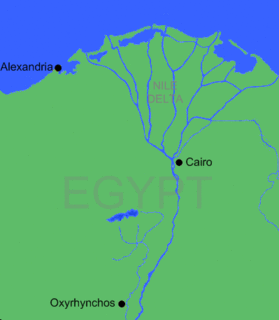Papyrus Oxyrhynchus 53 is a report on a persea tree, written in Greek. The manuscript was written on papyrus in the form of a sheet. It was discovered by Grenfell and Hunt in 1897 in Oxyrhynchus. The document was written on 25 February 316. It is housed in the British Museum. The text was published by Grenfell and Hunt in 1898.
Papyrus Oxyrhynchus 54 is a letter concerning the repair of public buildings, written in Greek. The manuscript was written on papyrus in the form of a sheet. It was discovered by Grenfell and Hunt in 1897 in Oxyrhynchus. The document was written between 27 March and 25 April of the year 201. It is housed in the Haskell Oriental Institute (2060) in the University of Chicago. The text was published by Grenfell and Hunt in 1898.
Papyrus Oxyrhynchus 81 is a declaration on oath by a tax collector, written in Greek. The manuscript was written on papyrus in the form of a sheet. It was discovered by Grenfell and Hunt in 1897 in Oxyrhynchus. The document was written between 244-245. Currently it is housed in the British Museum (757) in London. The text was published by Grenfell and Hunt in 1898.
Papyrus Oxyrhynchus 99 concerns the sale of half a house, written in Greek. It was discovered in Oxyrhynchus. The manuscript was written on papyrus in the form of a sheet The document was written on 4 September 55. Currently it is housed at the British Museum (756) in London.
Papyrus Oxyrhynchus 104 is a will, written in Greek and discovered in Oxyrhynchus. The manuscript was written on papyrus in the form of a sheet. The document was written on 26 December 96. Currently it is housed in the Cambridge University Library.
Papyrus Oxyrhynchus 124 is a student's composition, written in Greek and discovered in Oxyrhynchus. The manuscript was written on papyrus in the form of a sheet. The document was written in the 3rd century. Currently it is housed in the library of Winchester College in Winchester.
Papyrus Oxyrhynchus 125 is a declaration on oath, written in Greek and discovered in Oxyrhynchus. The manuscript was written on papyrus in the form of a sheet. The document was written on 13 December 560. Currently it is housed in the Egyptian Museum (10062) in Cairo.
Papyrus Oxyrhynchus 126 is a notice to a revenue officer, written in Greek and discovered in Oxyrhynchus. The manuscript was written on papyrus in the form of a sheet. The document was written on 10 May 572. Currently it is housed in the Egyptian Museum (10085) in Cairo.
Papyrus Oxyrhynchus 134 is the second in a series of Oxyrhynchus papyri (133–139) concerning the family affairs of Flavius Apion, his heirs, or his son. This one is a receipt from a stonemason given to Flavius. It is written in Greek and was discovered in Oxyrhynchus. The manuscript was written on papyrus in the form of a sheet. The document was written on 9 June 569. Currently it is housed in the Egyptian Museum (10053) in Cairo.
Papyrus Oxyrhynchus 141 is an order to a butler to make some payments of wine, written in Greek and discovered in Oxyrhynchus. The manuscript was written on papyrus in the form of a sheet. The document was written on 19 December 503. Currently it is housed in the Egyptian Museum (10096) in Cairo.
Papyrus Oxyrhynchus 142 is a tax receipt, written in Greek and discovered in Oxyrhynchus. The manuscript was written on papyrus in the form of a sheet. The document was written on 15 November 534. Currently it is housed in the British Museum (769) in London.
Papyrus Oxyrhynchus 147 is a receipt, written in Greek and discovered in Oxyrhynchus. The manuscript was written on papyrus in the form of a sheet. The document was written on 7 April 556. Currently it is housed in the Egyptian Museum (10074) in Cairo.
Papyrus Oxyrhynchus 149 is a receipt, written in Greek and discovered in Oxyrhynchus. The manuscript was written on papyrus in the form of a sheet. The document was written on 22 September 572. Currently it is housed in the Egyptian Museum (10045) in Cairo.
Papyrus Oxyrhynchus 151 is a receipt, written in Greek and discovered in Oxyrhynchus. The manuscript was written on papyrus in the form of a sheet. The document was written between 28 September and 27 October 612. Currently it is housed in the Egyptian Museum (10094) in Cairo.
Papyrus Oxyrhynchus 265 is a fragment of a Marriage Contract, in Greek. It was discovered in Oxyrhynchus. The manuscript was written on papyrus in the form of a sheet. It is dated to 81-96. Currently it is housed in the Thomas Fisher Rare Book Library of the University of Toronto in Toronto.
Papyrus Oxyrhynchus 267 is a fragment of an Agreement of Marriage, in Greek. It was discovered in Oxyrhynchus. The manuscript was written on papyrus in the form of a sheet. It is dated to 22 May 37. Currently it is housed in the Milton S. Eisenhower Library of the Johns Hopkins University in Baltimore.
Papyrus Oxyrhynchus 281 is a fragment of a Complaint against a Husband, in Greek. It was discovered in Oxyrhynchus. The manuscript was written on papyrus in the form of a sheet. It is dated between years 20-50. Currently it is housed in the library of the Royal Holloway College in Surrey.
Papyrus Oxyrhynchus 287 is a fragment of a Payment of Corn, in Greek. It was discovered in Oxyrhynchus. The manuscript was written on papyrus in the form of a sheet. It is dated to the 23 November 23. Currently it is housed in the library of the Columbia University in New York City.




